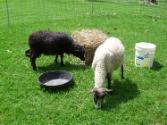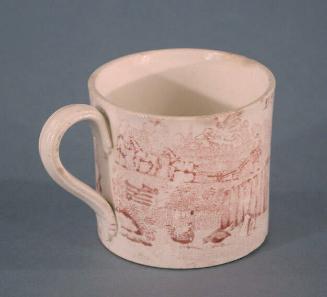Shetland Sheep Farmers at Hill-Stead Museum, 2010
SubjectPortrait of
Anne Foss
Date2010 May 8
Mediumborn digital photography
ClassificationsGraphics
Credit LineConnecticut Cultural Heritage Arts Program collections
CopyrightIn Copyright
Object number2015.196.743.1-.4
Description2015.196.743.1-.2: Photographs of Anne Foss, one of the owners of Clatter Ridge Farm, with Shetland sheep that graze on the grounds of the Hill-Stead Museum, at May Market 2010.
2015.196.743.3-.4: Photographs of Shetland sheep from Clatter Ridge Farm grazing at Hill-Stead Museum May Market 2010.
NotesSubject Note: The Hill-Stead Museum in Farmington, Connecticut holds an annual May Market public event featuring local craftspeople selling their artworks. Farmers Anne Foss and Bobbie Emery, owners of Clatter Ridge Farm in Farmington, bring their Shetland sheep to the Market for visitors to see, and they sell products made from the wool. The Connecticut Cultural Heritage Arts Program (CCHAP) developed a collaboration with Clatter Ridge Farm to use wool from the Shetland sheep in the carpets made by Hartford Bosnian weavers who participated in the Sewing Circle Project.2015.196.743.3-.4: Photographs of Shetland sheep from Clatter Ridge Farm grazing at Hill-Stead Museum May Market 2010.
Subject Note: The Sewing Circle Project began in 2007 as an initiative to encourage production, marketing, and sustainability of traditional crafts among the many immigrant and refugee communities in the Greater Hartford area and across the state. Developed by the Connecticut Cultural Heritage Arts Program (CCHAP) based at the Institute for Community Research (ICR) in Hartford and at the Connecticut Historical Society after 2015, the project supported the remarkable traditional arts of these newcomers. Members of the Sewing Circle met regularly at ICR and the Hartford Public Library to work on their art forms, learn new skills, and share coffee and conversation. This cooperative environment fostered social interaction among the artists and public audiences, respected and encouraged their cultural heritage and artistic traditions, stimulated literacy improvement, and helped to develop marketplaces for their artwork. CCHAP organized gatherings, exhibits, workshops, marketplace events, promotional materials, and educational activities for the group’s participants. While most of the artists experienced war, trauma, and dislocation, they continue to practice their cultural heritage and artistic traditions, blending these with current experiences and materials to create artwork that is both beautiful and functional. Even when immigrants and refugees embrace a move that takes them to a more stable and prosperous place, resettlement poses challenges of physical and psychological adaptation. Many new Americans have eased transition by continuing, recreating, or reinventing familiar art forms. For many members of refugee communities now living in New England, practicing their familiar arts of weaving, knitting, basket making, lace making, music, dance, and storytelling helps them to cope with the trauma of the genocide and displacement their families have suffered.
Engaging with public audiences has given project participants a chance to improve their English-speaking skills and broaden their social networks and support systems. The project has been a great success because it brings some additional income to the artists and also because they have become friends and co-workers sharing techniques, styles, and supplies as they create their unusual and exquisite textiles. In collaboration with Catholic Charities Migration and Refugee Services and the Hartford Public Library, the project is expanding to offer small business training to the artists, thanks to grants from the Aurora Foundation, the Avon Hello Tomorrow Fund, the Aetna Foundation, and the Knox Foundation.
Through a partnership with Clatter Ridge Farm, whose sheep graze on the grounds of the Hill-Stead Museum in Farmington, Connecticut, Fatima Vejzovic and other Bosnian weavers created a series of weavings using their high-quality Shetland wool. The undyed wool gives the rugs a beautiful softness and durability as well as subtle variations of natural color. These special weavings are in the collection of the Hill-Stead Museum, the Connecticut Historical Society, and several private collections.
Additional materials exist in the CCHAP archive for this event and the Bosnian community.
Cataloging Note: This project was made possible in part by the Institute of Museum and Library Services MA-245929-OMS-20.
Status
Not on viewHaris Gusta Guya
2011 November 4

















